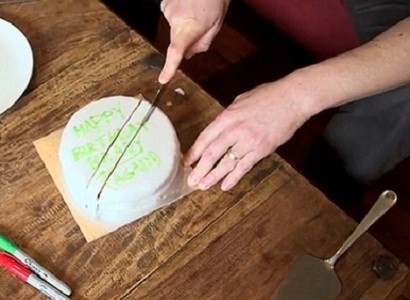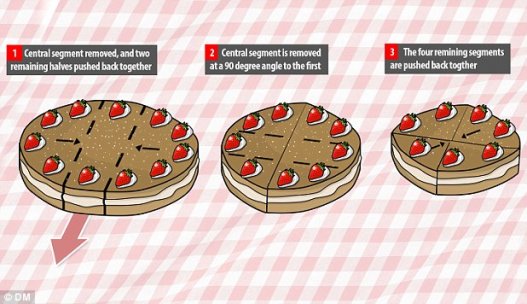Think you know how to cut a cake? Think again: Scientist reveals 100-year-old trick involving parallel lines and rubber bands
 Forget everything you know about cake cutting; this new method could turn the seemingly straight-forward practice on its head. Although, using the word ‘new’ isn’t accurate, because the method is actually a 100-year-old trick unearthed by London-based author and mathematician Alex Bellos. In his latest YouTube video, Bellos describes how taking wedges out of cakes leaves them susceptible to drying - and we should instead be cutting them in lines so the whole cake can be sealed and stored. Known on YouTube as Numberphile, Bellos first explained the problems with modern methods of cutting cakes. Namely, he said that if a wedge is taken out of a cake but the rest of the food is then stored in the fridge, the edges of the cake open to the air will be ‘dry and horrible’, Bellos says. ‘You’re not maximising the amount of gastronomic pleasure that you can make from this cake.’
The method was first published in Nature on 20 December 1906 in the letters to the editor section by English mathematical scientist Francis Galton. Titled ‘Cutting a round cake on scientific principles’, Galton’s letter explained how the ‘ordinary method of cutting out a wedge is very faulty’. He went on to state the cake should be cut in parallel lines, starting in the centre, with the rectangular segments of the cake then taken out and eaten. This would allow the cake to then be closed, provided it is one with icing, keep the sponge inside sealed and retaining its freshness. It is also recommended an elastic band is used to hold the cake together and keep it sealed. ‘I don’t know if you’ve thought about it before but these triangular slices are really annoying anyway because it’s not very satisfying,’ Bellos added. In reference to the new method he said having ‘a nice uniform slice like that is a lot better.’ But, he concluded, most people choose to share their cakes rather than eating it themselves, meaning not much or any of it is often stored. ‘I think for the mathematical loners who don’t want to share their cakes it could be useful,’ he joked. |




















